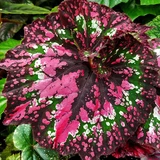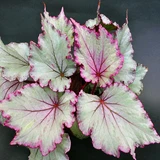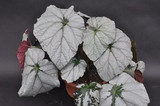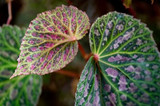PRO FILES: Become an Expert on...Begonias!
- Oct 27, 2023
- 6 min read
Begonias may well be one of the best known groups of tropicals, but we find they're also among the least-understood. Here's some pro-level insight into the world of these
remarkable plants.
OVERVIEW
Begonias form a plant family unto themselves, Begoniaceae, and it's actually one of the largest families of flowering plants on earth. While most of us hear the name and envision either the beloved Wax Begonia (B. semperflorens) that decorated our grandmas' gardens as well as their homes, or perhaps the beautiful, quilted foliage of the Rex Begonias (B. rex), there are actually a wide range of forms, colors, and leaf-types among Begonias, including ones treasured by collectors for their blossoms, their foliage, or sometimes both! Surprisingly, the Begonia family shares a scientific order with some plants we might not readily associate as being related--the Cucurbits (melons, squash, pumpkins, cucumber, and similar fruiting vines!) While not exactly "siblings", these plants are all sort of "kissing cousins", sharing some distinguishing physical characteristics and a common genetic heritage.
Unlike their distant cousins, Begonias are prized almost exclusively for their beauty. Though a very few species are used in cooking in some parts of the world, all Begonias contain a fair dose of oxalic acid in their tissues (the same naturally-occurring chemical compound that makes many Philodendrons and Dieffenbachias toxic), and none should ever be consumed regularly. Unless you're intimately familiar with their biochemical properties, we recommend never attempting to eat any Begonia (and besides, they're far more decorative than Arugala or Romaine!)
ORIGINS
Begonias are native to much of the tropics and subtropics around the world, preferring moist areas that typically have high humidity. Though some are adaptable in cultivation, knowing their natural habitat helps us understand how best to care for them. Their distribution includes South and Central America, the southern regions of Asia, and much of Africa in appropriate habitat.
In the wild, Begonias may grow as terrestrial (soil-growing) plants, epiphytes (clinging to trees, rocks, or other substrates) or semi-epiphytically (a combination of the two.) In terms of anatomy, Begonias are known for having asymmetrical leaves (often with a "porkchop" or modified oval shape, sometimes with the leaf tips extended into "angel wings." Flowers of all Begonias are monoecious (Greek, "one house"), meaning they come in either male or female, with no single flower having all the parts needed for making seeds (in botanical terms, this is called an "imperfect flower.") Begonia seeds are typically fine and almost dust-like, designed to be spread abroad by the wind when the pods dry and naturally split (dehiss.)
VARIETY
There are many ways of categorizing Begonias, but the most useful for the gardener is the separation based on physical traits, mostly the form of their roots. The commonly-recognized categories under this system are:

A hybrid Rhizomatous Begonia
Rhizomatous
Rhizomatous Begonias have fleshy, moist stems (rhizomes) that tend to trail or
creep along the soil surface, producing multiple branches or growth points, often
full of flowers in their season.

Wax Begonia (B. sempervirens), a popular type of Fibrous-Rooted Begonia
Fibrous-Rooted
Fibrous-rooted Begonias, as the name implies, generally have a network of fine,
hair-like roots that help anchor them in loose or shallow soils. This group consists
of some of the most familiar--and iconic--species for the collector, including Angel
Wing / Dragon Wing Begonias, Wax Begonias (that favorite of Grandma's), and
many of the Cane Begonias.

Double-flowered Tuberous Begonias
Tuberous
Yet another type of fleshy-stemmed Begonia, the tuberous species have an
enlarged underground stem (tuber) that helps store water and nutrients to carry
the plant through seasonal dormancy. Many tuberous varieties have been
hybridized to selectively produce double, rose-like flowers in bright primary and
pastel shades.
to these categories based on root-type, we can also add:

Begonia grandis, a hardy Begonia often grown outdoors in the South
Hardy Begonias
Representing various cultivars of the species Begonia grandis, these plants are
mostly grown outdoors in USDA zones 7 and above, where they are reliably
winter-hardy. Though their flowers are on the smaller size compared to some of
the showiest floral varieties, their ability to grow outdoors makes them a popular
choice for many Southern gardens.

A beautiful hybrid Rex Begonia
Rex Begonias
Begonia rex is a sub-group of the fibrous-rooted begonias, grown mainly for their
amazing, showy leaves, often marked with bright colors and sometimes
contrasting leaf veins. Breeders have focused much attention on developing new
B. rex varieties in response to their wild popularity among indoor gardeners and
plant collectors. Many of the newer varieties are in fact patented and can't be
legally propagated without licensing and the payment of royalty fees to the patent
holder.
USES
As we've noted, Begonias include species like B. rex which are almost entirely
desired for their foliage, some like the tuberous-rooted Begonias, whose flowers
are the real star of the show, and some that pull double-duty with both attractive
foliage and dazzling blooms. Wax Begonias, especially, are popular as bedding
plants, often planted in large swaths outdoors where their shiny, waxy leaves and
cheerful flowers bring a welcome splash of color from spring to autumn. Some
others, such as cane-type and angel wing Begonias, are used either in containers
or in beds as focal points, rising tall above their smaller relatives and bringing both
color and texture to the garden. Tuberous and some fibrous-rooted species are
popular subjects for hanging baskets, and many other fibrous-rooted species,
especially the beloved Rex Begonia, are perennial favorites as houseplants and
prized subjects for the ardent collector.
CARE
In general, the care of Begonias, like all tropicals, is best informed by
understanding the foregoing facts about their natural habitat and growth patterns.
Although details like humidity requirements may vary significantly, no Begonias are
particularly adapted for arid conditions. At the same time, most grow in places
where water is plentiful and consistent, but where porous, well-aerated soil allows
moisture to drain away. As a result, wet roots are an almost universal enemy of
Begonias, and they enjoy a potting medium that doesn't readily compact or
become waterlogged. At Specialty Tropicals, our usual Begonia potting mix
consists of a 50/50 mix of soilless mix and perlite, sometimes with the addition of
fir bark for certain forest-dwelling species.
Taller cane-type Begonias often require some means of support as they grow or,
alternatively, consistent pruning to keep them from becoming top-heavy and
unwieldy. Others grow best in terrarium conditions, where jungle-like humidity is
easily maintained. A trait common to many, but not all, is their preference for
bright indirect light. (A few, such as the Wax Begonias, are happy to live where
they receive substantial direct sun, but these are the exception.) Perhaps their
nature as understory plants, typically growing in the dappled shade of other plants
and trees, has contributed to their great popularity as houseplants, due to their
tolerance of lower light than some other plants demand.
In our greenhouses, Begonias thrive under 70% shade cloth with average 70%
humidity and temperatures ranging from 65 F. at night to a maximum of 90 F.
during the warmest days. Their soil is allowed to dry just slightly on top between
waterings, and we use both a slow-release fertilizer in pellet form and a monthly
foliar spray of a seaweed-based fertilizer that contains micronutrients for maximum
health and best growth. For foliage begonias, our usual NPK (Nitrogen-
Phosphorus-Potassium) ratio is a balanced 20-20-20 slow-release fertilizer pellet.
For foliar feeding, we typically dilute to about 30-50% of the manufacturer's
recommended ratio, and find this works well. As famous New England gardener
author James Crockett espoused in his Victory Garden books and television series,
the best rule of thumb for fertilizing plants is "weakly, weekly"--in other words,
when in doubt, fertilizer is better applied at lower concentration and more
frequent intervals, than too much at once. In our experience, the combination of
slow-release balanced pellets designed for tropical plants with the micronutrient
boost of a seaweed fertilizer is perfect. As for water, the home gardener's best
rule of thumb is to let the plant guide its own care, watering when the soil surface
has had time to dry slightly since the last watering, but always before the plant has
a chance to wilt. While Begonias will generally recovered from moderate wilt, it's a
definite sign they need more water. If, however, the plant becomes "watery" or
"mushy" looking and begins to slump, too much water is likely the culprit. Always
grow Begonias in containers that have adequate drainage holes, and for best
success, we recommend placing them in a humidity tray (simply a large shallow
saucer or plastic tray, larger than the spread of the plant, with coarse gravel lining
the bottom so the pot is never sitting in water, but runoff from watering can
accumulate and provide needed humidity as it evaporates.
As with all our wonderful plants, please feel free to contact us for information or assistance at any time. We're always happy to "talk shop" about our favorite subject, and we love to help our customers succeed in their passion to grow beautiful specimens!























Comentários